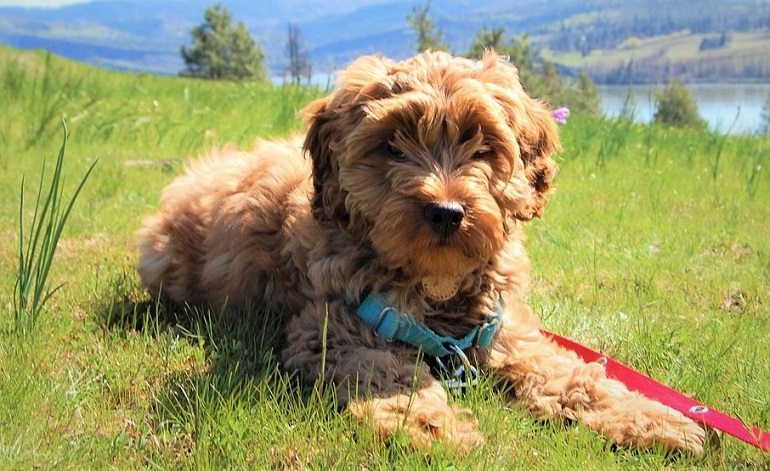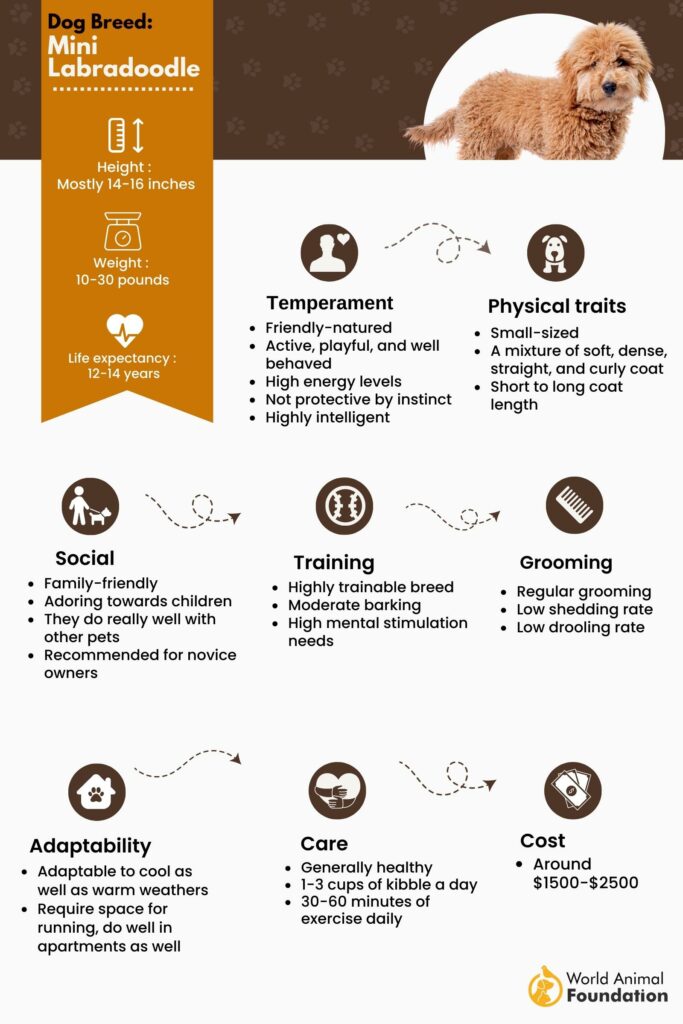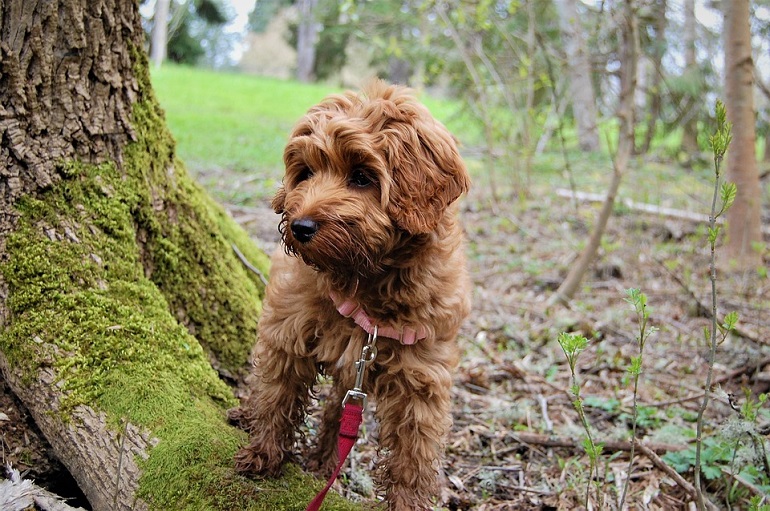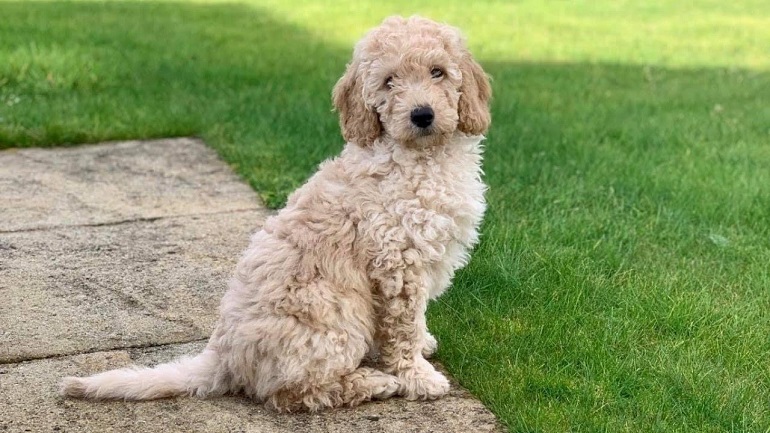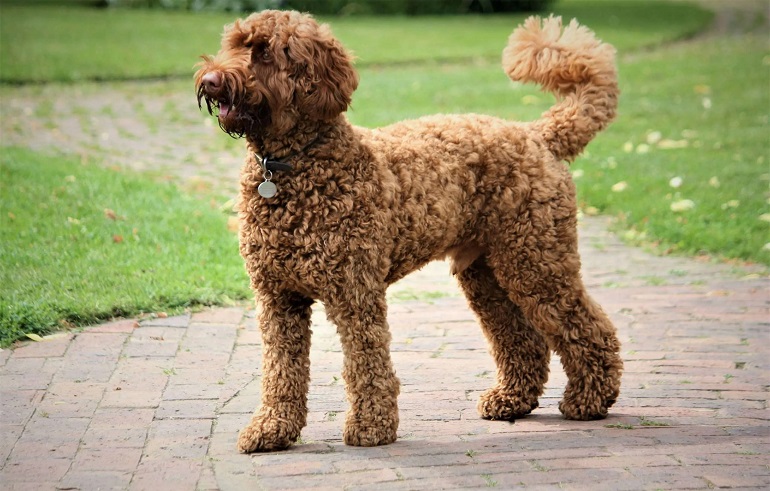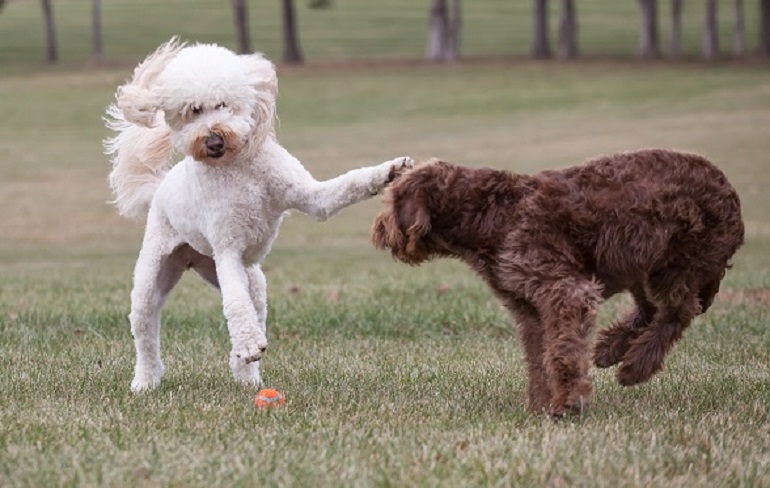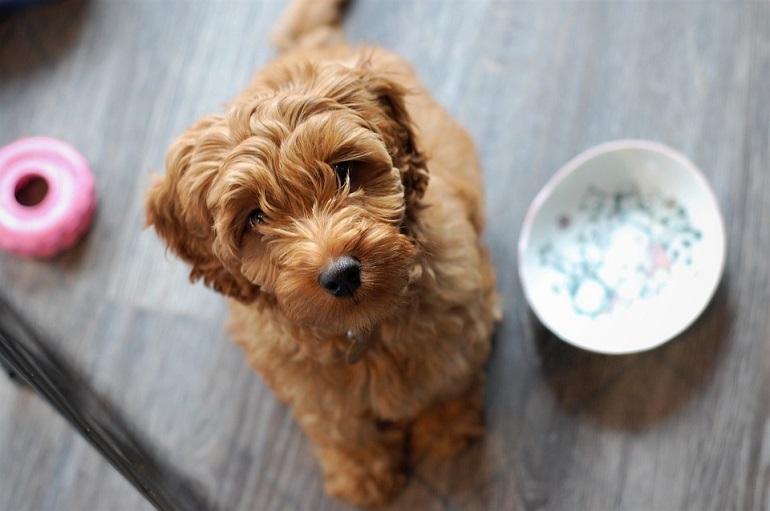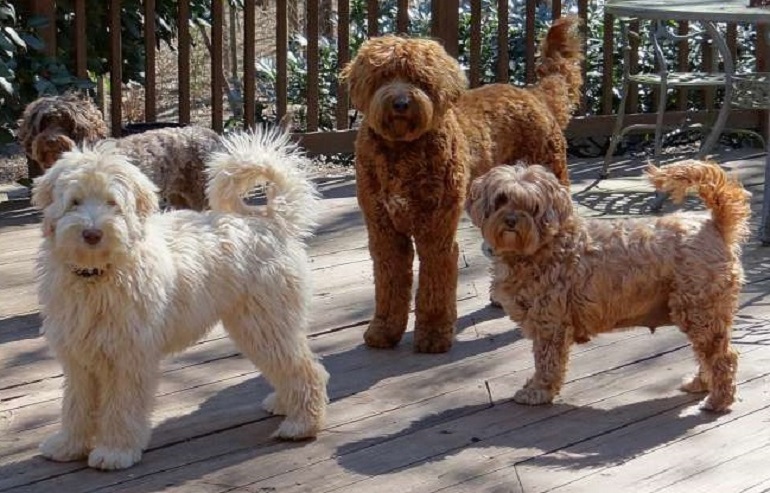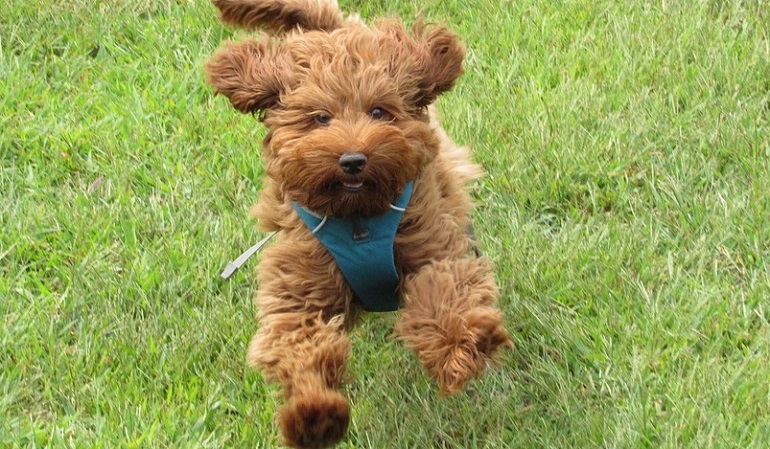The Mini Labradoodle, a charming blend of Labrador Retriever and Miniature Poodle, is a popular choice for families seeking a loving and intelligent companion. This comprehensive guide dives into everything you need to know about this adorable hybrid breed. From their playful personalities and hypoallergenic coat variations to grooming requirements and training tips, we’ll explore what makes Mini Labradoodles unique. Whether you’re a potential owner or simply curious about this delightful dog, prepare to discover the fascinating world of the Mini Labradoodle.
Overview
If you want a cute, fluffy designer dog that’s not too big or too small, a Miniature Labradoodle may be a good fit for you. These cute little designer dogs can be great family pets and good companions for work-at-home people.
Mini Labradoodles are a popular crossbreed between the Labrador Retriever and the Miniature or Toy Poodle. They were bred for those who loved the standard Labradoodle but wanted something smaller.
This crossbreed is a popular choice for both experienced and new dog owners because of their calm temperament. They get along with other people and dogs and are easy to train. They can be stubborn, but they are very reward-driven.
They’re also popular thanks to their coat being more or less hypoallergenic. Even someone with allergies can potentially keep this dog.
About the Breed
The Miniature Labradoodle is a crossbreed of two well-loved purebred dogs: Labradors and Miniature Poodles.
The idea originally started when breeders bred purebred Labrador Retrievers and standard Poodles to make more hypoallergenic dog breeds with Labrador friendliness and intelligence, creating the standard Labradoodle.
But as wonderful as Labradoodles are, they can get pretty huge. Both the Labrador and the standard-sized Poodle are pretty big.
So reputable breeders started breeding the purebred Labrador Retriever with the purebred Miniature Poodle to make a smaller version: the Mini Labradoodle.
These cute little dogs are known for having big personalities despite their smaller bodies. They love their humans and can sometimes be protective of them. They also love running around and playing.
Mini Labradoodles are highly intelligent, like their parents, and are very easy to train. They’re also very playful, making them perfect for children.
They combine the loyalty, intelligence, and easy trainability of the Labrador with the low-shedding, more allergy-friendly coat of the Standard Poodle and Mini Poodle.
While they’re smaller than standard Labradoodles, they still have the lovable characteristics that gave the Labradoodle its popularity among humans.
Vital Statistics
- Height: 14-24 inches, highly dependent on parents
- Weight: 10-30 pounds, highly dependent on parents
- Average lifespan: 12-14 years
- Energy level: High energy and needs lots of exercise
- Trainability: Highly intelligent dogs and easily trainable
- Shedding: Low shedder, high grooming needs
History of the Mini Labradoodle
Miniature Labradoodles are a relatively new crossbreed. They are believed to have been bred in Australia in the 1980s when a breeder made the first successful cross of a Labrador Retriever and a Mini Poodle.
The designer dog was created by Wally Cochran, a member of the “Royal Guide Dogs.” The goal was to create service dogs that didn’t shed too much and could also support their owners.
Some people needed service dogs but couldn’t handle the shedding coat from the Labrador. And so, a reputable breeder wanted to mix the Labrador Retriever with a breed having a non-shedding coat. The standard Poodle was the perfect candidate.
Both standard Labradoodles and Miniature Labradoodles came along from this need. First, the standard Labradoodle came along. Standard Labradoodles were popular but much too big for some people. So then the Lab was mixed with the Mini Poodle to make a smaller pup.
Because of the dog’s popular characteristics and smaller size, this dog breed became an instant hit when it was seen in America. It’s been one of the more popular breeds for the past few decades since then.
Mini Labradoodle Facts
- A crossbreed of the Labrador Retriever and the Miniature Poodle that started around the late 1980s
- Can make a great service dog or a therapy dog thanks to its loyalty, trainability, and friendliness
- Can come with a soft, curly coat from the Poodle side or a dense, straight coat from the Labrador side
- Mini Labradoodles can come in many colors depending on the parent’s genetics, including apricot, white, or brown.
- Generally needs 1-2.5 cups of quality kibble per day
- Despite the name, the size of a Mini Labradoodle can vary depending on what genes they inherit from the parents
- Mini Labradoodle cost is anywhere between $500-$2,500
Mini Labradoodle Lifespan
The average lifespan of a Miniature Labradoodle is usually around 12-14 years. You should have a good decade or so before you have to worry about health problems related to aging.
That said, your dog’s lifespan depends on various health factors and its lifestyle. Some dogs may live longer or shorter lives depending on how healthy they are.
Make sure you’re keeping your Miniature Labradoodle on the best diet, keeping them at the best weight, and getting them checked by the vet regularly. Lifestyle management can help maximize the time you have with your dog.
Be on the lookout for health issues potentially passed down from the parents. Hip problems, obesity, and other related health problems may affect your pup’s lifespan if left unchecked.
Mini Labradoodle Appearance
Following are some of the key factors specific to Mini Labradoodle.
Size
Miniature Labradoodles are meant to be smaller versions of the Labradoodle. The designer dog mixes the traits of Labrador Retrievers and Toy Poodles to make a smaller dog. Smaller individuals may be around 14 inches tall.
That said, the exact size may depend on the characteristics of the parents. These dogs still come from a fairly big breed. Larger individuals may be closer to 24 inches tall.
It can be difficult to determine how big a Mini Labradoodle puppy will get until they grow.
Weight
Smaller Mini Labradoodles may weigh around 10 pounds or more. Again, they may be bigger and heavier depending on the genes inherited from their Lab and Mini Poodle parents. Larger individuals may weigh up to 30 pounds.
Coat
The Mini Labradoodle is meant to have the Poodle coat, a low-shedding coat that is allergy-friendly. The coat type and color can vary from individual to individual based on the genes of the Poodle parent or Labrador parent.
Some coats may have a wool texture, coming from their Poodle genes. These coats require a lot of grooming. Other coats may be a soft, fleece texture. It may be wavy or curly.
Some individuals may also have a hairy, straight coat closer to that of Labrador Retrievers rather than a Poodle coat.
Color
Mini Labradoodles can come in many colors. They may also be single-colored or multi-colored. It depends on the genes they inherit from their very different-looking parents.
Your Mini Labradoodle puppy may have the Lab’s chocolate brown, black, or yellow colors. But if they have more of the Mini Poodle’s genes, they may come in a wide range of colors. They can come in apricot, black, cream, gray, silver/white, or beige.
Mini Labradoodle Temperament and Personality
Mini Labradoodles are believed to be the perfect family pet and companion because of their family-friendly characteristics. They are great with kids and other animals and are all-around easy to get along with.
That said, they can also be protective of their family. This can result in protective behavior like growling and biting if you’re not careful. It’s important to start socializing your pup early to avoid problems.
While they’re usually an easygoing breed, these cute little hairballs can have a stubborn streak to them. But they’re also very reward-driven, and more than that, they love making you happy, which makes them easy to train despite their stubbornness.
Although having a small size and a mostly calm temperament, Mini Labradoodles are high-energy breeds as they’re bred from two high-energy parents.
They like to play and exercise, and they’ll need plenty of it. Don’t expect to be dealing with a couch potato who sits around all day.
Miniature Labradoodles can get lonely easily, and they do not like being left alone for too long. Leaving them alone for eight hours or more a day may lead to depression, separation anxiety, and the destruction of your furniture.
As adorable and friendly as they are, they may not be the best for families that are out of the house all day.
Mini Labradoodle Food and Diet
The Mini Labradoodle generally needs about 1.5-2.5 cups of high-quality kibble daily, preferably broken up into two meals. Like any dog, make sure you’re feeding them quality dog food with no fillers and proper nutrients to support them.
As tempting as it can be, avoid overfeeding your Mini Labradoodle with high-fat treats, no matter how much they beg. Like their parent breed, the Labrador, they can get overweight if overfed. Also, keep their age in mind; puppies and senior dogs need different kibbles.
Mini Labradoodles (and any breed) should be kept on a puppy-based kibble until they are a year old to ensure they get the nutrients needed to grow properly.
Seniors, meanwhile, may need senior food that helps them get the most nutrients out of their food. As they age, some dogs have trouble getting the nutrients they need from normal kibble and lose weight at an alarming rate.
Don’t be afraid to ask for a vet’s recommendation if you’re having trouble finding out which kibble is best for your Mini Labradoodle.
Family Compatibility
Mini Labradoodles are great family dogs because of their friendliness. They can get along great with families and other pets. These dogs are also very playful and love family interaction.
You can potentially take your Mini Labradoodle on hikes, trips, or errands without too much trouble. While they can get along with children, it’s important not to leave any dog and a small child alone unsupervised just to be safe.
Children should also be taught not to be too rough with them, no matter how easygoing they are. No jumping on them, pulling their tails or ears, or chewing on them. Even the gentlest dogs have limits.
While these dogs are mostly friendly, it’s still important to train them to be accepting of new family members or friends entering the house. You don’t want to lock the dog up every time a visitor comes over, right?
These dogs are best suited for a family that doesn’t leave the house too much. Mini Labradoodles can get lonely easily and even depressed if left alone for too long.
They may work best for work-at-home families or retirees who don’t have a busy schedule.
Mini Labradoodle Health and Care
Mini Labradoodles are considered to be fairly healthy dogs. They aren’t prone to some issues that other dogs are. That said, they can suffer from some health conditions passed down from their parent breeds.
Some health concerns these dogs may be at risk of are hip dysplasia, obesity, and bloat.
Hip dysplasia occurs when the hip develops incorrectly as a puppy, causing problems later on. It can cause pain and dysfunction as the dog grows. Over time it can cause problems like arthritis and mobility issues.
Obesity is a common problem among Labradors that can be passed down to their Mini Labradoodle children. Therefore, avoiding high-calorie treats and overfeeding them too much is best.
Obesity can cause a range of other health problems in the future, like arthritis or joint pain. So it’s best to always stay on top of your dog’s weight.
Progressive retinal atrophy can harm a dog’s eye cells and potentially cause blindness in the future. This is a hereditary disease passed down from Labradoodle parents. Mini Labradoodle puppies are more susceptible if their parents had it.
You should ensure that a puppy’s parents did not have progressive retinal atrophy before buying a Mini Labradoodle puppy. Do not breed your Mini Labradoodle for Mini Labradoodle puppies if they have this disease.
Exercise-induced collapse occurs when a dog overexerts itself while exercising. This particular problem is more common among Mini Labradoodles, so keep an eye on them when running around. This can be life-threatening.
While your Miniature Labradoodle is running around and exercising, watch for symptoms like a lack of coordination, muscle weakness, or other signs of exhaustion. Make sure they stop and take a break if they seem to be tiring themselves out.
Owners should also be careful of diseases like hypothyroidism. In addition, you should clean their ears periodically to avoid ear infections.
Mini Labradoodles need consistent grooming and coat care to keep their fur from matting and getting messy. They need to be groomed multiple times a week, at the least. Daily brushing is recommended if possible.
These dogs are incredibly active, coming from two very active breeds. They need a good 30-60 minutes of exercise a day. Whether it’s long walks, mental stimulation, or playtime, they need plenty of exercise each day.
A Mini Labradoodle home should have ample space to run around, whether it’s in a fenced-in yard or a wide area indoors. They enjoy running and need to be able to burn off all that energy.
Mini Labradoodle Training
The Miniature Labradoodle is considered very easy to train, even for new dog owners. They’re eager to please and very food-driven. When all else fails, you can pull out a bag of dog treats to get their attention.
Owners shouldn’t have much trouble teaching this pup cool tricks like sit, stay, down, and any other trick you can think of. They’re highly intelligent dogs and quick to learn. You should start training early to avoid behavior problems later on.
Keep a bag of low-calorie treats handy during the early days of training. Praise good behavior with a treat as soon as it shows desirable behavior.
If your Miniature Labradoodle does something wrong, do not lash out at them, as it may worsen things. Punishments like hitting may lead to fear or aggression that would not have existed without it. Instead, redirect them to the right behavior and then reward them.
Despite the breed’s small size and well-behaved personality, you should still take steps to socialize your Mini Labradoodle puppy, and obedience train them as early as possible. These little guys can be stubborn and set in their ways if you wait too long.
They love their humans, but they can also be a bit protective of them. Teaching your Mini Labradoodle puppy early on that other people and animals are safe is a good way to avoid any future problems like growling or lashing out at strangers.
Trust me; you do not want to wait until your dog starts getting nervous about new people and animals to start socializing them. Once they start getting antisocial, it gets harder to mingle them. So go ahead and start taking them out and letting strangers give them treats and pets.
Don’t assume that because the Miniature Labradoodle is small and friendly, it can’t bite or scare someone if not trained properly. No matter how small a dog is, it can lash out once they’re scared of someone.
If you’re a new dog owner whose never trained a dog before, there are many training collars and leashes out there to help you and your Mini Labradoodle puppy get the hang of leash training.
FAQ’s
Below are some frequently asked questions about Mini Labradoodles.
Do Mini Labradoodles Bark a Lot?
Miniature Labradoodles are not known for barking a lot. Depending on the individual, they may occasionally bark at the door or bark while playing. They may also bark at new people or animals if they aren’t socialized properly.
This breed is generally seen as a moderate barker. They may bark when they see a reason to, but they usually won’t bark just for the sake of making noise.
Any excessive barking can usually be addressed through positive training by rewarding quiet behavior.
Can Mini Labradoodles Be Left Alone?
While Mini Labradoodles can be left alone for a short amount of time, it’s best not to leave them for long periods. These dogs are very people-centric and can get depressed if they’re separated from you for too long.
They may get into trouble and chew things up out of frustration or just get depressed to the point of illness.
Never leave a young Mini Labradoodle puppy alone. They may get into something and get themselves hurt.
Is the Mini Labradoodle Hypoallergenic?
The non-shedding coat of the Miniature Labradoodle is more allergy-friendly than most. They have a low shedding coat that shouldn’t set off allergies as much. As a result, they’re a potentially good choice for anyone with allergies, unlike many other dogs.
That said, there’s still no guarantee that someone won’t have an allergic reaction. Dogs shed, even if it’s just a little. While they don’t shed as much as other dogs, some people may be set off by even the Mini LLabradoodle’sfur.
Conclusion
Mini Labradoodles are great designer dogs for novice dog owners looking for an easygoing companion who’s highly trainable. TThey’realso a great choice for families who want a dog that anyone in the family can get along with, including children. They can also be a good choice for those with concerns about allergies.
These small to medium designer dogs are intelligent, loyal, and love pleasing their humans, much like their parent breeds.
They need early training and socialization just like any breed, but as long as you train them properly, they’ll make well-behaved, lovable companions.
It is important to give them proper exercise, as they’re very high-energy despite their size. Mini Labradoodles also require consistent attention and will get lonely if you leave them alone for too long.
Make sure you have the means to care for any dog you decide to get.
Mini Labradoodles, a charming blend of Labrador Retriever and Miniature Poodle, offer a compelling option for those seeking a smaller, allergy-friendly companion. Their intelligence, affectionate nature, and playful energy make them wonderful family pets. While individual temperaments vary, proper training and socialization are vital for a well-adjusted Mini Labradoodle. Potential owners should be prepared for grooming commitments and understand the importance of reputable breeders to minimize health risks. Ultimately, this delightful crossbreed can bring years of joy to families prepared to meet their needs.

